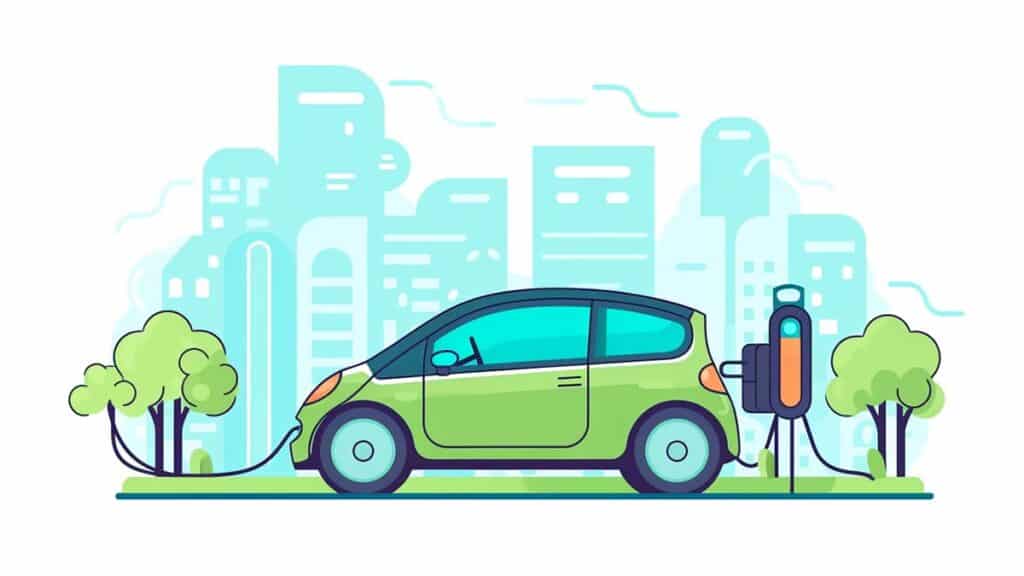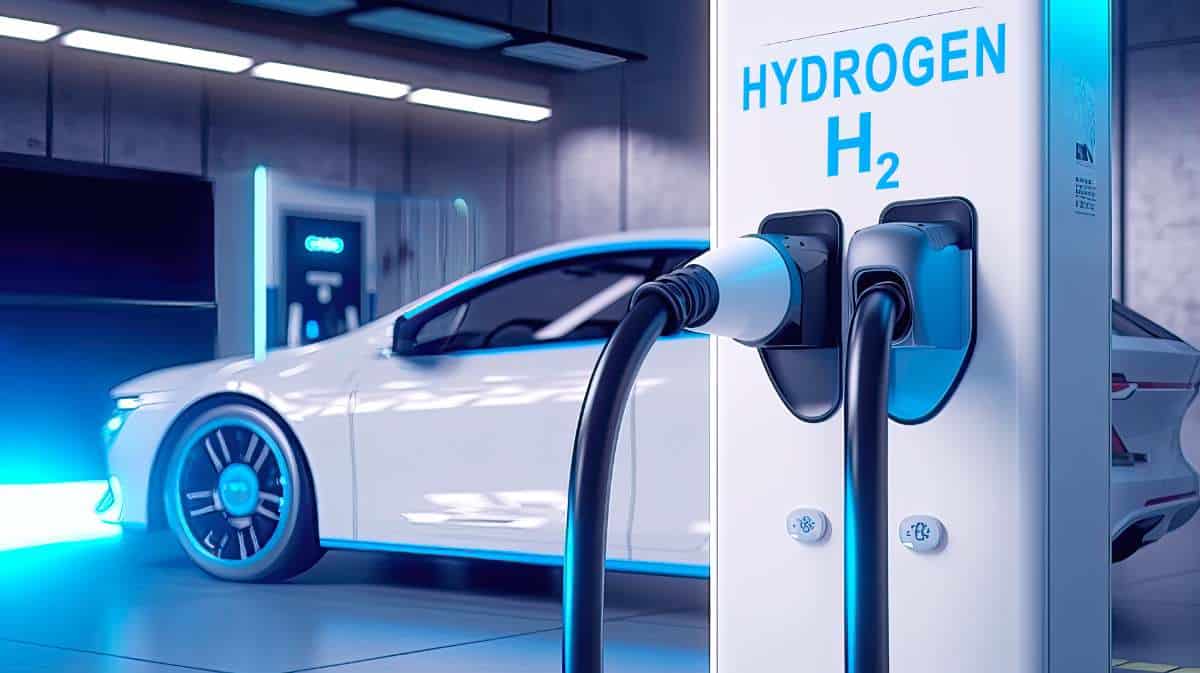Air pollution, particularly from vehicle emissions, has significant negative effects on public health, air quality, and climate. With transportation being one of the main contributors to air pollution and greenhouse gas emissions in the U.S., finding solutions to reduce these emissions is crucial.
One standout solution is the widespread adoption of zero-emission vehicles (ZEVs), which do not produce any harmful tailpipe emissions.
As they emit no greenhouse gases or harmful air pollutants, ZEVs have the potential to greatly improve air quality and reduce the impact of transportation on climate change.
By supporting clean air initiatives and transitioning to ZEVs, the U.S. can maintain a path toward meeting long-term climate goals while benefiting public health and the environment.

Key Takeaways
- Zero-emission vehicles (ZEVs) can significantly improve air quality and reduce greenhouse gas emissions caused by transportation.
- Widespread adoption of ZEVs is vital for the U.S. to achieve its clean air and climate goals.
- Various strategies, such as legislation and state-level ambitions, are being employed to promote the transition to ZEVs in the U.S.
The Negative Effects Of Vehicle Pollution On Public Health In The U.S.
Latest Statistics On Health Conditions And Deaths Caused By Air Pollution
Air pollution caused by vehicles poses a significant threat to public health.
Emissions from internal combustion engines contain harmful pollutants that can have severe consequences on human health, particularly for vulnerable populations such as children, the elderly, and individuals with pre-existing respiratory or cardiovascular conditions.
Pollution and Respiratory Diseases
According to the World Health Organization, approximately 4.2 million deaths per year are due to exposure to ambient (outdoor) air pollution.
More than 80% of people living in areas that monitor air pollution are exposed to air quality levels that exceed WHO limits.
Studies have shown that in cities with high levels of pollution, there is an increased rate of chronic bronchitis, lung cancer and acute respiratory infections.
In terms of asthma, a study published by the Journal of Allergy and Clinical Immunology found that traffic-related air pollution caused asthma symptoms in children leading to approximately 4 million new cases per year.

Another study published by the American Lung Association showed that people who live in places with polluted air have a higher chance – up to 27% more likely – of developing bronchitis compared with those living in areas with cleaner air.
Furthermore, research carried out by The Lancet Planetary Health journal found a direct correlation between long-term exposure to airborne pollutants and inflammation in the respiratory system.
The study suggests this could lead to other health issues including cardiovascular problems which contribute significantly towards global mortality rates each year.
For instance, ozone can increase the frequency of asthma attacks, cause shortness of breath, and even cause permanent damage to lungs through long-term exposure.
Elevated ozone levels are linked to increases in hospitalizations, emergency room visits, and premature death ¹.
Mortality and Premature Deaths
Vehicle pollution has been associated with an increased mortality rate.
Particulate matter, a component of vehicular emissions, is singlehandedly responsible for up to 30,000 premature deaths ² each year in the United States. Moreover, the adoption of zero-emission vehicles (ZEVs) can have a significant impact on public health.
If ZEVs made up a majority of the passenger vehicles in ten key states by 2050, it would help prevent over 2,200 premature deaths ³, thus alleviating the strain on healthcare systems.
ZEVs and Improved Public Health
The widespread adoption of zero-emission vehicles (ZEVs) has the potential to provide major public health benefits.
According to a report by the American Lung Association ⁴, electrification of the transportation sector can significantly reduce harmful air pollution, thereby improving public health across the United States.
By transitioning to ZEVs, cleaner air and better health outcomes can be achieved, which is essential in meeting air quality and climate goals.

The Importance of Achieving Clean Air
Benefits of Improved Public Health By Eliminating Air Pollution
Clean air is crucial for the well-being of the environment and the population. Air quality plays a significant role in public health. The implementation of the Clean Air Act has led to a reduction in air pollution, resulting in a drastic decrease in cases of serious health effects.
Actions taken under the Clean Air Act ⁵ have led to dramatic improvements in air quality and public health.
Enhanced air quality promotes better respiratory health and reduces the risks related to exposure to hazardous pollutants. Fostering a cleaner environment can also contribute to a more sustainable future for generations to come.
Statistics Regarding Hospital Bills Saved and Work Days Saved By Eliminating Air Pollution In The U.S.
Eliminating air pollution does not only improve public health, but also heavily impacts economic factors.
A reduced number of hospital visits and medical treatments translate into lower healthcare costs for both individuals and society. This, in turn, leads to a lower financial burden for the country.
Furthermore, healthier citizens lead to an increase in productivity as fewer workdays are lost due to pollution-related illnesses. Investing in clean air measures is not only beneficial for health, but it also bolsters the economy and contributes to overall sustainability goals.
U.S. Greenhouse Gas Emissions Caused By Transportation
The transportation sector plays a significant role in contributing to greenhouse gas emissions in the United States. Accounting for about 29 percent of total U.S. greenhouse gas emissions ⁶, it stands as the largest contributor among all sectors.
Emissions have increased in absolute terms more than any other sector between 1990 and 2021. Mobile sources like cars, trucks, buses, and other vehicles generate a large portion of these emissions, contributing to the urgent need for innovative solutions.
The Importance Of Eliminating Greenhouse Gas Emissions
Addressing greenhouse gas emissions from the transportation sector is crucial for meeting national and international climate goals, and improving air quality.
The United States has committed to reducing its greenhouse gas emissions under the Paris Agreement by 50-52% by 2030 ⁷, and tackling emissions from the transport sector forms a vital component of this ambition.
Transitioning to more sustainable modes of transport, such as Zero Emission Vehicles (ZEVs), can significantly reduce the impact of the transportation sector on climate change and air pollution.
ZEVs include battery electric vehicles (BEVs), plug-in hybrid electric vehicles (PHEVs), and hydrogen fuel cell vehicles, among others.
These vehicles have the potential to help meet air quality and climate goals by completely eliminating or significantly reducing tailpipe emissions.
To support a cleaner transportation future, governments, businesses, and consumers must take action to accelerate the adoption of ZEVs.
This may involve investments in research and development, providing incentives for manufacturers and consumers of ZEVs, and building out the necessary charging and refueling infrastructure.
By focusing on eliminating greenhouse gas emissions from transport, the United States can make strides toward a sustainable and clean air future, benefiting public health and the environment.

What are Zero Emission Vehicles (ZEVs)?
Zero emission vehicles (ZEVs) are a category of vehicles that do not emit any harmful pollutants from their onboard source of power.
These environmentally-friendly vehicles leverage advanced technology to achieve zero greenhouse gas emissions while in operation, playing a crucial role in addressing air quality and climate change concerns.
Advantages of ZEVs
ZEVs offer significant benefits when it comes to air quality and climate goals. For instance, they produce no tailpipe pollution, thus reducing harmful emissions and improving local air quality.
By lowering the number of pollutants in the atmosphere, they help combat climate change and its negative effects on human health and the environment.
Additionally, operating ZEVs proves more energy-efficient, leading to reduced dependency on oil and enhancing overall energy security.
Types of ZEVs Available
There are multiple types of ZEV technology currently available, with each offering distinct advantages in transportation.
Battery electric vehicles (BEVs) are a popular choice, powered solely by rechargeable batteries, while plug-in hybrid electric vehicles (PHEVs) blend battery power with the use of a conventional internal combustion engine.
Furthermore, fuel cell electric vehicles (FCEVs) harness hydrogen fuel cells to produce electricity that powers the vehicle, emitting only water vapor as a byproduct.
As the demand for cleaner and more sustainable modes of transport grows, the availability and variety of ZEVs are expected to expand, ultimately contributing to a cleaner and more eco-friendly future.
Role of ZEVs in Promoting Clean Air and Reducing Greenhouse Gas Emissions
Impact of ZEV Usage on Air Pollution and Greenhouse Gas Emissions
Zero-emission vehicles (ZEVs) play a critical role in promoting clean air and mitigating climate change by reducing both air pollution and greenhouse gas emissions.
As these vehicles emit zero or nearly zero emissions while running, they help in significantly lowering smog and other harmful pollutants.
The widespread usage of ZEVs, such as electric vehicles, leads to improved air quality, particularly in urban areas where air pollution is a major concern.
How Much Do ZEVs Reduce Air Pollution Nationally?
The extent of air pollution reduction due to ZEV adoption depends on various factors, including the number of vehicles replaced and the type of power generation used for charging electric vehicles. While it is difficult to provide exact numbers, a shift towards ZEV adoption can potentially:
- Decrease harmful pollutants: Major pollutants emitted by conventional vehicles, such as nitrogen oxides (NOx), particulate matter (PM), and volatile organic compounds (VOCs), can be substantially reduced by using ZEVs.
- Enhance overall air quality: Reduction in the aforementioned pollutants leads to improved air quality in cities and urban areas, ultimately benefiting human health and the environment.
- Support national air quality standards: By reducing harmful emissions, ZEVs help countries meet their air quality targets and comply with stricter legislation on air pollution.
How Much Do ZEVs Reduce Greenhouse Gas Emissions Nationally?
The reduction of greenhouse gas emissions by ZEVs largely depends on the carbon intensity of the electricity used for charging electric vehicles. However, some key points showcasing the positive impact of ZEVs on greenhouse gas emissions are as follows:
- Lower CO2 emissions: Electric vehicles and other ZEVs produce significantly fewer CO2 emissions as compared to conventional cars, thereby contributing to the reduction of greenhouse gas emissions.
- Support climate goals: Adoption of ZEVs can help countries meet their climate change mitigation targets, as laid out in international agreements such as the Paris Climate Agreement.
- Reduce dependency on fossil fuels: The transition to ZEVs decreases the reliance on petroleum-based fuels for transportation, further reducing carbon emissions and supporting the global shift towards cleaner energy sources.
In conclusion, ZEVs play a vital role in both improving air quality and reducing greenhouse gas emissions. Their widespread adoption can lead to substantial environmental and public health benefits while supporting the achievement of national and international climate goals.

What Strategies Are Being Employed to Achieve A Clean Air Future With ZEVs In The U.S.?
Federal Air Quality and Climate Goals in the U.S.
The United States government is committed to reducing greenhouse gas emissions and improving air quality.
The Environmental Protection Agency has been enforcing the Clean Air Act since 1963. Last amended in 1990, this act sets requirements, limitations, and definitions regarding air quality and pollution to be applied throughout the United States.
Nationally, progress has been made towards achieving cleaner air and reducing the environmental impact of transportation by advancing the adoption of zero-emission vehicles (ZEVs).
Federal Regulations and Targets for ZEVs
As part of the effort to reduce greenhouse gas emissions from the transport sector, the U.S. government has set ambitious goals for the adoption of ZEVs.
In an August 2021 executive order ⁸, the Biden administration set a target of 50% of new car sales to be ZEV by the year 2030.
For example, President Biden’s Executive Order on catalyzing American clean energy industries sets the Federal fleet on a path to achieve 100% zero-emission vehicle acquisitions by 2035.
This will establish a strong precedent for other industries to follow and help to enhance the shift towards sustainable transportation nationwide.
Federal Policies and Incentives to Encourage ZEV Adoption
In addition to setting regulatory targets, the U.S. government also provides policies and incentives to support the widespread adoption of ZEVs.
These measures include a tax credit, as well as promoting investments in charging infrastructure to increase the convenience and accessibility of electric vehicle ownership.
The integration of ZEVs into the transportation system not only reduces greenhouse gas emissions but also contributes to a cleaner and greener future, with significant benefits for air quality and public health.
ZEV Ambitions And Legislation At The State Level
California’s Visionary ZEV Program Sets The Bar
California leads the way in promoting zero-emission vehicles (ZEVs) with ambitious policies and regulations. The state’s commitment to clean transportation reflects in its bold ZEV regulations, fostering innovation and setting a high benchmark for other states and nations to follow.
For instance, California has mandated that by 2035 all new light-duty vehicles must be zero emission vehicles, and has recently banned the sale of new diesel trucks by 2036, ensuring a transition to zero emission vehicles within the heavy duty transport sector.
These progressive initiatives are a testament to the state government’s dedication to combat climate change and air pollution. Moreover, California’s commitment extends beyond personal vehicles – encompassing even heavy-duty trucks – to ensure a comprehensive approach to clean transportation.

The Thirteen U.S. States That Have Implemented A More Ambitious ZEV Program Than The Federal One
Besides California, 13 other US states have adopted the ZEV program, incorporating more stringent regulations than the federal government.
These states have recognized the potential of ZEVs in reducing greenhouse gas emissions and improving air quality, and they aim to accelerate the transition towards a cleaner transportation system.
These states have embraced California’s pioneering vision, enacting policies to incentivize the adoption of ZEVs while forging their paths in clean transportation.
The widespread adoption of ZEV mandates across these states sends a strong message to automakers and governments, highlighting the growing consensus on the importance of sustainable transport in tackling climate change.
The collective efforts of these 14 states demonstrate the power of government policy in shaping the future of transport and fostering innovation in the pursuit of a cleaner and healthier environment.
The steadfast commitment to ZEV programs at the state level serves as an inspiration for other regions and countries to follow suit, although it remains to be seen whether all fifty U.S. states will eventually take up their own ZEV mandate.
Conclusion
The adoption of zero-emission vehicles (ZEVs) plays a crucial role in meeting air quality and climate goals.
As governments worldwide prioritize clean transportation, policies such as California’s ban on the sale of new diesel trucks by 2036 demonstrate a commitment to reducing pollution and emissions.
A key component of this transition is the Zero Emission Vehicles program, which originated in California and has been adopted by 13 other states. This program encourages the production and sale of ZEVs, resulting in cleaner air and reduced greenhouse gas emissions in the transportation sector.
Governments can further support the adoption of ZEVs by implementing policies that provide incentives for purchasing electric vehicles, building charging infrastructure, and offering tax breaks for both individuals and companies.
Collaboration between policymakers, the private sector, and consumers is essential in achieving a clean air future.
In conclusion, ZEVs are a vital component of efforts to improve air quality and address climate change. Continued government support, effective policies, and increased public awareness can drive the transition towards a sustainable and clean transportation system.
Frequently Asked Questions
How do ZEV policies contribute to meeting emission standards?
Zero Emission Vehicles (ZEVs) play a crucial role in meeting emission standards, as they produce no tailpipe emissions.
Policies supporting ZEVs, such as incentives for adoption and investment in charging infrastructure, are helping states and jurisdictions meet health-based pollution targets and climate goals.
By replacing traditional fossil fuel vehicles with ZEVs, emissions of harmful pollutants are significantly reduced, contributing to improved air quality and public health outcomes.
What is the impact of electric vehicle mandates on emissions?
Electric vehicle mandates, such as those set by the California Air Resources Board (CARB), require a certain percentage of new vehicle sales to be zero-emission vehicles.
This accelerates the adoption of electric vehicles (EVs) and other ZEVs, helping to reduce emissions from the transportation sector. Research has shown that the adoption of electric vehicles can lead to a significant decrease in air pollution and result in improved public health outcomes.
What are the key regulations for clean air vehicles?
Key regulations for clean air vehicles, such as the Zero Emission Vehicle (ZEV) regulation in California, aim to reduce air pollution and minimize the associated health risks by setting ambitious targets for ZEV adoption.
For example, California has moved to accelerate 100% new ZEV sales by 2035, ultimately aiming to clean the air, slash climate pollution, and save consumers money. Additionally, actions under the Clean Air Act have led to significant reductions in air pollution, preventing hundreds of thousands of cases of serious health effects.
References:
- https://www.epa.gov/clean-air-act-overview/air-pollution-current-and-future-challenges
- https://www.ucsusa.org/resources/vehicles-air-pollution-human-health
- https://www.nrdc.org/bio/simon-mui/zero-emission-vehicles-protect-public-health-save-lives
- https://www.lung.org/getmedia/99cc945c-47f2-4ba9-ba59-14c311ca332a/electric-vehicle-report.pdf
- https://www.epa.gov/clean-air-act-overview/progress-cleaning-air-and-improving-peoples-health
- https://www.epa.gov/transportation-air-pollution-and-climate-change/carbon-pollution-transportation
- https://www.whitehouse.gov/wp-content/uploads/2021/10/US-Long-Term-Strategy.pdf
- https://www.whitehouse.gov/briefing-room/statements-releases/2021/12/08/fact-sheet-president-biden-signs-executive-order-catalyzing-americas-clean-energy-economy-through-federal-sustainability/
- Tesla Charger Installation Cost (Home Setups) - March 1, 2024
- Tesla Phone Key Disconnected (Troubleshooting Guide and Quick Fixes) - March 1, 2024
- Tesla FSD 12 (Explained) - March 1, 2024